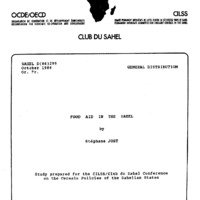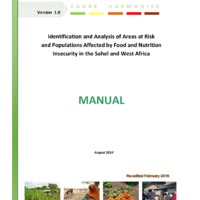Recherche
11 items
35th CILSS Day September 12, 2020
"The COVID-19 pandemic effects on food and nutrition security in the sahel and west Africa and CILSS adaptation efforts for information production"
Adapting to climate variability and change in smallholder farming communities: a case study from Burkina faso, Chad and Niger
Climate variability and change is regarded as having major impacts on key sustainable socio-economic and environmental indicators in Sub-Saharan West Africa. Because of these concerns, we investigated smallholders knowledge, skills, and aspirations about managing climate change, and document adaptation strategies used in the semi-arid regions coming from Burkina Faso, Chad and Niger. We analyzed climate data from the 1950’s to the present, including daily and aggregated rainfall and temperature variability, trends and extremes.
Evaluation of the regulatory framework for pastoralism and cross border transhumance in West Africa and the Sahel
i) The Economic Community of West African States (ECOWAS) is a pioneer in establishing regulations for the exercise of cross-border transhumance, a somewhat controversial livestock production system in relation to its economic, social and environmental impacts, and the conflicts of access to natural resources that are sometimes associated with it.
ii) Since 1998, ECOWAS has been experimenting with a set of legal and technical instruments to provide a framework for the exercise of this multi-functional credited activity, which makes it a powerful means of strengthening the resilience of populations in general, and pastoralist and herder households in particular, on the one hand, and promoting social and regional integration in West Africa, on the other.
Identification and Analysis of Areas at Risk and Populations Affected by Food and Nutrition Insecurity in the Sahel and West Africa
Facing recurrent food and nutrition insecurity affecting Sahelian and West African populations, governments and their development partners have set up mechanisms to monitor food situation. However, these mechanisms do not use the same methodological approaches, which often lead to results that are difficult to compare and which at times are even contradictory. Aware of this situation and the need to find a suitable solution, CILSS member states and partners have initiated the development of a Cadre harmonisé d’identification et d’analyse des zones à risque et des populations en insécurité alimentaire et nutritionnelle au Sahel et en Afrique de l’Ouest (Harmonized Framework for Identification and Analysis of Areas at Risk of and Populations Affected by Food and Nutrition Insecurity in the Sahel and West Africa). This tool, known as “Cadre Harmonisé” (CH), is expected to serve as a framework for countries to assess food and nutrition insecurity on an objective and consensual basis. The purpose of the Cadre Harmonisé is to help countries prevent food crises better and, where appropriate, quickly identify affected populations and appropriate measures to improve their food and nutrition security. The related method has been developed by a group of food and nutrition security experts from CILSS, FAO, WFP, FEWS NET, AFD, IPC/GSU, JRC/EC and UNICEF, and from international NGOs Oxfam International, Save the Children and ACF1. It is worth recalling that starting from 2008, various meetings held by the CH Technical Committee agreed for the CH to include some elements of the Integrated Food Security Phase classification version 1 (IPC 1.0). The IPC is a set of tools and procedures for classifying food and nutrition insecurity severity for decision making. Since the development of a manual for IPC 2.0, discussions have been under way to bring the CH closer to the IPC to incorporate lessons learned that improve comparability of results from the two tools. Similar to the IPC, the Cadre Harmonisé seeks to make best use of a set of tools and procedures for classifying the nature and severity of current and projected food and nutrition insecurity situations on the basis of a consensual analytical framework and classification scale. The CH is based on the following four conceptual models commonly used by national, regional and global mechanisms: Risk = f (Hazard, Vulnerability) Sustainable Livelihoods Framework The UNICEF Nutrition Conceptual Framework The four dimensions of food security (availability, access, utilization, and stability) The CH therefore is an integrated analytical framework built on a technical consensus that seeks to make best use of data from all systems or methods, namely food consumption surveys, nutrition surveys, the Household Economy Approach (HEA) or other information provided by agricultural surveys and market monitoring. The CH assesses food and nutrition insecurity, based on convergence of evidence from several indicators. The CH uses a food insecurity severity scale with five phases. Such a severity scale, which is an international one, makes it possible to make comparisons between countries of the sub-region and also at global level. CILSS was mandated to develop and implement the CH as a common tool for Sahelian and West African countries. Its analysis cycles will from now on help develop regional mapping of current food and nutrition situations and analyze projected situations. 1 Other institutions such as MIFRAC, IBIMET and CARE International initially contributed to the development of the present analytical framework. Cadre Harmonisé MANUAL Version 1.0 Page | 13 The CH also seeks to strengthen the regional integration framework in the CILSS-ECOWAS-UEMOA region so that collaborative and harmonized analyses of food and nutrition situations are conducted through the best possible use of other tools and analysis methods developed by national mechanisms and partners. Given the importance of the process of harmonizing the analytical framework for food and nutrition situations in West Africa, it is necessary that all food and nutrition security stakeholders take ownership of it and make it their decision-making tool. Furthermore, efforts are needed to strengthen the partnership framework within countries and to support the operations of early warning systems in order to improve the collection of reliable data. CH implementation relies on existing data collection mechanisms. Efforts should be made by countries and partners to provide financial support to these mechanisms - as CH implementation will from now on be the baseline reference for activating regional food reserves and mobilizing technical and financial partners (TFPs).
Identification of the swat model parameters on the bani catchment (west africa) under limited data condition
Results showed that the model performance can be judged as very good (Moriasi et al., 2007) especially considering limited data condition and high climate, land use and soil type variabilities in the studied basin (Figure 1). Prediction uncertainty is acceptable: most of the observed data (around 80& ) are bracketed by the 95PPU within an acceptable width (R-factor < 1). However, model is characterized by more prediction uncertainties during high flows (Figure 2). The most sensitive parameters are mostly related to surface runoff reflecting the dominance of this process on the streamflow generation (Table 1).
Informative directory on regulations an agreements related to the prevention and management of pastoral conflicts in the Sahel and West Africa Volume 1 : ECOWAS and central couloir country of trahsnumance (Bénin, Burkina Faso, Niger et Togo)
Pastoralism and transhumance are livestock production practices in Africa in general and West Africa in particular. Moreover, continental, sub-regional and national organisations consider that pastoralism is useful for preserving and increasing livestock production. On the whole, this practice is faced with various difficulties, notably clashes between the different users of natural resources. In order to maintain social peace, which contributes to the promotion of regional development and integration, continental, supranational and national bodies have enacted legal texts and policy guidelines to enable pastoralists to carry out their activities in peace alongside the other economic actors. As a reminder, it can be noted that "a regulation is a legal concept that covers a set of legal instruments in the form of laws, decisions, rules and regulations, and other legal texts that frame a social and economic activity, etc. It is, in fact, about subjecting an activity to regulations”. Regulations govern activities related to the movement of people and their economic activities. To this end, the African Union, ECOWAS, UEMOA, States and communities, through legislative and regulatory measures, have laid down strong legal and institutional foundations to facilitate the movement of animals in their sub-regional and national areas. Between 1998 and 2004, ECOWAS, UEMOA and other partners adopted several legal texts and policy documents to regulate cross-border transhumance and reduce conflicts between farmers and herders, and then to protect public health, in the light of the global health environment (resurgence of animal diseases transmissible to humans). In order to control transhumance and reduce conflicts between herders and farmers, the States have adopted, since independence, laws that have been adapted to regional regulations. Despite this body of legislation, conflicts remain and the management of transhumance is still a major concern in the States and at the cross-border level. In order to contribute to better application of the regulations, the Integrated and Secure Livestock Farming and Pastoralism Project (PEPISAO), financed by the Agence française de développement (French Development Agency) (AFD) and coordinated by ECOWAS, which has delegated the implementation of Components 1 and 2 to CILSS, is working to promote the most relevant texts and also to facilitate their accessibility. The elaboration of the information directory of regulations required a process that helped to identify regulations relating to the prevention and management of pastoral conflicts with regard to the measures to be taken before going for, during and after transhumance, procedures for settling cases of field damage, natural resource management, access to resources, etc. The main regional and national texts have been compiled to extract relevant information to facilitate accessibility, better understanding and application by field actors
Special Bulletin of the 2024 Seasonal forecasts of the Agro-Hydro-Climate characteristics for the Sahelian and Sudanian zones of West Africa and the Sahel PRESASS 2024
The 2024 Edition of the PRESASS was organized from April 22 to 26, 2024 in Abuja, Nigeria, by AGRHYMET Regional Climate Center for West Africa and the Sahem (AGRHYMET RCC-WAS) of the CILSS, in collaboration with ACMAD, the National Meteorological and Hydrological Services (NMHSs), WMO and the West African River Basin Organizations.
.......Generally a wet rainy season is expected in 2024 over the Sahelian belt, with late to normal starting dates of the agricultural season in the Sahel-Central and early to normal s in the Sahel-West and East; late to normal ending dates of the agricultural season; short dry spells at the beginning of the season in the Sahel-West and medium to long dry spells in the Sahel-East and generally long dry spells towards the end of the season over the entire Sahelian belt; and above-average runoff in the main Sahelian river basins.......
Training module on conflict-sensitive journalism related to mobile livestock production systems in West Africa and the Sahel
Mobile livestock production systems have been facing a number of challenges over the past twenty years, including farmer-pastoralist conflicts and civil insecurity in West Africa and the Sahel. In recent decades, conflicts initially sparked by competition over natural resources have gradually evolved into struggles for control of land between socio-cultural groups, and politico-religious demands that have intensified the displacement of both animals and people. At the same time, we note that the media - print, radio and audiovisual - most often focus on pastoral issues, such as the management of land conflicts between farmers and herders, and access to transhumance corridors. Pastoralists and pastoral households are therefore most often described in terms of this general conception of pastoral farming as vulnerable to climatic, environmental, health and terrorist risks, and as inefficient in the context of agricultural modernisation policies. All in all, these observations lead us to conclude that pastoral livestock farming is a production system that is not only under-represented, but also little-known by the media in West Africa and the Sahel, who more often than not are content to relay current representations and official events about it.
What are the prospects for the evolution of mobile livestock systems in relation to the ongoing political, technological and social mutations in West Africa and the Sahel? Thematic Reflection Note 3 June 2021
PEPISAO aims to strengthen the capacities of States and regional and national actors so that they can develop approaches to secure livestock mobility and integrate livestock farming methods in line with a shared regional vision and offering maximum guarantees for the peaceful cohabitation of different users of natural resources. In order to achieve this ambition, the ECOWAS Commission, in collaboration with UEMOA and CILSS, has initiated a prospective reflection on mobile livestock systems. Such an exercise reflects an anticipatory approach based on the analysis of relevant factors of change for the future of livestock systems. The present note, which is part of this exercise, aims to characterise the socio-political dynamics at work in the region, in relation to mobile livestock systems. The link between anticipation and strategic planning is tenuous. Moreover, the challenge of exploring the likely future of transhumance and consequently the future of millions of people - development actors in their own right of territories for which they are overlooked - is of crucial importance for regional integration and stability of the region and for peaceful cohabitation between socio-cultural groups. Studies, regional programmes and high-level meetings have multiplied in recent years, reflecting both the acuteness of the issue for the various actors and the complexity of the process of constructing political and social arrangements at the relevant levels of decision-making and action in the areas concerned by these problems.
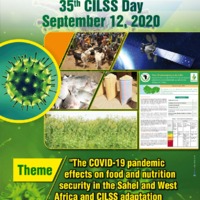
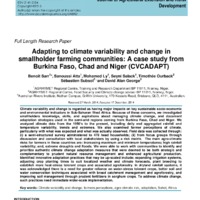
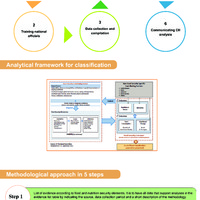
![[2020] Evaluation regulatory framework pastoralism and transhumance in West Africa EN_VF.pdf application/pdf thumbnail](/application/asset/thumbnails/default.png?v=2.0.2)
